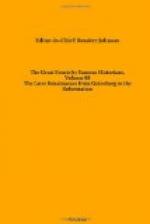“The chief author and instrument of this salutary grant was the Cardinal of Spain (Mendoza), who had seen that, in consequence of the great liberty of past years, and from the mingling of Moors and Jews with Christians in all sorts of conversation and trade, many things went out of order in the kingdom. With that liberty it was impossible that some of the Christians should not be infected. Many more, leaving the religion which they had voluntarily embraced as converts from Judaism, again apostatized and returned to their old superstition—an evil which prevailed more in Seville than in any other part. In that city, therefore, secret searches were first made, and they severely punished those whom they found guilty. If their delinquency was considerable after having kept them long time imprisoned, and after having tormented them, they burned them. If it was light, they punished the offenders, with the perpetual dishonor of their family. Of not a few they confiscated the goods, and condemned them to imprisonment for life. On most of them they put a sambenito, which is a sort of scapulary of yellow color, with a red St. Andrew’s cross, that they might go marked among their neighbors, and bear a signal that should affright and scare by the greatness of the punishment and of the disgrace; a plan which experience has shown to be very salutary, although, at first, it seemed very grievous to the natives.”
Cardinal Mendoza might have been an instrument of establishing the new tribunal in Spain, but no author was wanted for that work. Pope Gregory IX, fit successor of Innocent III, had completed in Spain, as in the county of Toulouse and kingdom of France, the scheme which his uncle Innocent began. By a bull, dated May 26, 1232, he appointed Dominican friars inquisitors in Aragon, and forthwith proceeded to confer the same benefit on the kingdoms of Navarre, Castile, and Portugal; Granada being in possession of the Moors. Ten years later, in a council at Tarragona, the chief technicalities of the Spanish Inquisition were settled. At the invitation of Peter, Archbishop of Tarragona, Raymund of Penaforte, the Pope’s penitentiary, presided. The definitions of the council are notable for the determination they evidence to conduct the affairs of the tribunal with entire legal precision and formality. The “vocabulary” was now settled, and one has only to turn to the Acts of the Council of Tarragona to find the exact meaning of “heretic, believer, suspected, simple, vehement, most vehement, favorer, concealer, receiver, receptacle, defender, abettor, relapsed.”




